Today is the first day of the week of low tides dedicated to Snapshot Cal Coast, a statewide citizen science project headed in my area by the California Academy of Sciences. This week groups and individuals will be making photographing the organisms they see in the ocean or along the coast, and uploading observations to iNaturalist. Participants will include both scientists and non-scientists, making the week-long event one of the biggest citizen science projects that I regularly take part in. Next Monday I’ll be taking a group of Seymour Center volunteers and staff up to Davenport to conduct a Bioblitz. The other days I’ll be out on my own, or with 1 or 2 people.
This morning the low tide was very early (-1.3 feet at 05:09), so I stayed close to home and went to Natural Bridges. The tide was low but the swell was big and I wasn’t able to get down to the low spots I could normally reach with this kind of tide. However, this meant that I could spend more time in the low-mid-intertidal, where there is a lot of biodiversity to document.
Today I want to write about polychaete worms. These are the segmented marine worms in the Phylum Annelida, which also includes earthworms and leeches.
Worm #1: Phragmatopoma californica
One of the most conspicuous inhabitants of this zone is the tube-dwelling polychaete worm, Phragmatopoma californica. This worm has a couple of common names: honeycomb worm, which refers to the mounds of tubes they build; and sandcastle worm, for the fact that the tubes are built of cemented sand grains. In effect, these worms are tiny masons!
Each of the tubes is inhabited by a single worm. Mounds form because competent Phragmatopoma larvae, looking for a place to settle out and live permanently, are attracted to the tubes of existing adults. This phenomenon is called gregarious settlement. Once settled and metamorphosed, juvenile worms build their tubes by selecting sand grains and cementing them together around a lining of chitin-like material. How they do it, underwater, nobody knows. And these tubes are tough! The worm inside is skinny, and a humongous one would be all of 4 cm long, but it takes a lot of force to pry apart those sand grains. The openings to the tubes are 5-10 mm in diameter. Each worm can close off its tube with a circular-ish disc of stiff, fused chaetae called an operculum; this protects the worm from both predators and desiccation.
When the tide is out the worms withdraw into their tubes and clap the operculum down. They wait for the water to return. Phragmatopoma is a filter feeder; like most of the tube-dwelling polychaetes these worms use a crown of ciliated tentacles to create water currents that draw food particles to the mouth. When the tide is in the worms pull down the operculum and extend their feeding tentacles into the water. In the field, this is the most you can see of the worm’s body.
Worm #2: Serpula columbiana
Many polychaetes live in tubes, and tubes can be made of a variety of materials. Phragmatopoma californica builds tubes out of sand grains. Another worm that I saw today, Serpula columbiana, builds tubes out of CaCO3 precipitated from seawater. Like other animals that build calcareous skeletons, S. columbiana may in the future have difficulty precipitating CaCO3 in an increasingly acidic ocean. Tubes of Serpula worms are white when new and soon become fouled with algal growth, and tend to wander over the substrate. The best photo I could take this morning is a little blurry but you can see the general morphology of the tubes.
These worms are incredibly shy, and react to any perceived threat by pulling into their tubes. Their tentacles have tiny eyespots that can detect changes in light, so passing a hand over them can cause them to withdraw. Fortunately I was able to sneak up on one lazy worm in a pool, and grab a shot of its ‘head’ region. Worms that live in tubes are poorly cephalized, with none of the structures that we generally associate with a head. Serpula columbiana‘s ‘head’ looks like this:
The tentacles of S. columbiana are morphologically complex compared to those of Phragmatopoma. Serpula‘s tentacles are pinnate, or feather-shaped, and in cross-section look like a V. Cilia on the side branches of the tentacle create the feeding current, and food particles are transported by other cilia down the trough of the V to the mouth.
See that long, trumpet-shaped structure? That’s the worm’s operculum!
Worm #3: Unidentified cirratulid
Unlike Serpula and Phragmatopoma, worms of the Family Cirratulidae don’t live in tubes. Instead, they live with most of the body hidden in crevices, and extend tentacles to feed.
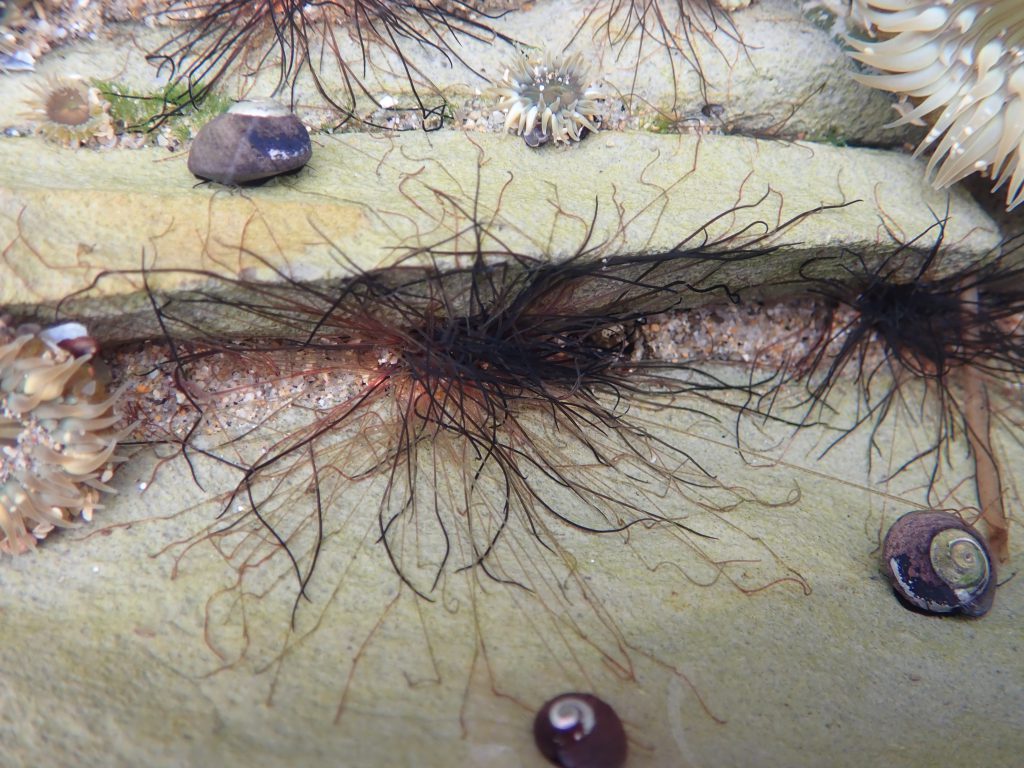
13 June 2018
© Allison J. Gong
As you can imagine, it is extremely difficult to identify a worm when all you can see of it are its tentacles; with the rest of the body hidden in a crevice, there are no visible characteristics to use to distinguish species. Cirratulids use their tentacles to feed, but in a way that is entirely unlike how Phragmatopoma and Serpula use theirs. Instead of feeding on particles suspended in the water, cirratulids are deposit feeders. They sweep their tentacles across the surface and collect organic deposits. Sticky mucus on the tentacles picks up organic matter, and cilia on the tentacles sweep the organic matter to the worm’s mouth.
Don’t believe me? Watch this!
It doesn’t matter if the surrounding substrate is sand or rock. The cirratulid’s sticky tentacles are very effective at gathering organic muck.
Worm #4: Flabesymbios commensalis
This worm remains an enigma. There doesn’t seem to be much known about its biology. I have seen them twice, both times on the body of purple urchins (Strongylocentrotus purpuratus), and although the genus name has changed twice since the first time, I’m pretty sure it’s the same worm. As the species epithet commensalis implies, this worm is a commensal on sea urchins. This means that it neither harms nor benefits its echinoderm host. Similar to the worm I’ve seen on bat stars, F. commensalis presumably cruises over the urchin’s body and feeds on detritus or scraps of kelp that the urchin grabs.
When I took the photo in a tide pool this morning I didn’t see the worm. It wasn’t until I downloaded the pictures from the camera onto my computer that I saw it. See how well it blends in with the urchin’s color?
Here’s a tighter crop of that photo:
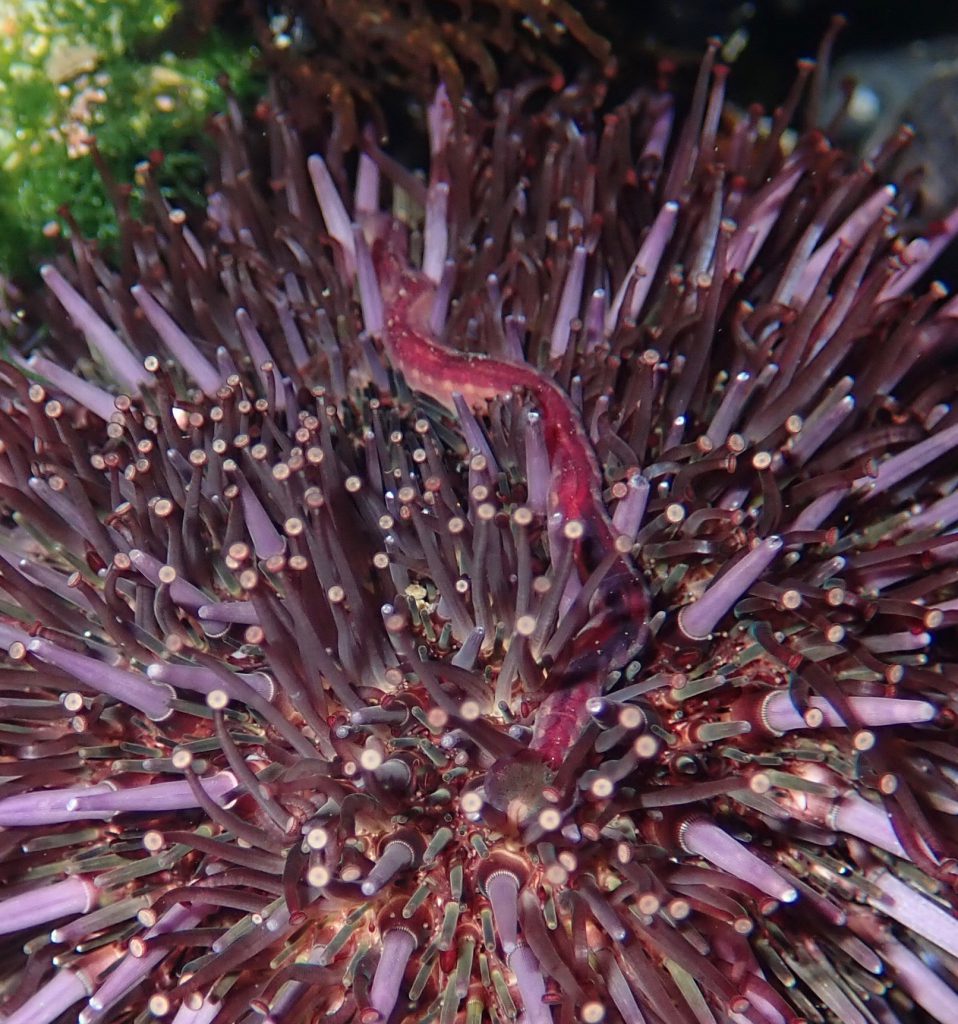
13 June 2018
© Allison J. Gong
For many polychaete worms, another animal’s body seems to be the ideal habitat. And for some reason, echinoderms are likely hosts for such commensal worms. I’ve written about the bat star worms, here is the urchin worm, and there’s also a scale worm that I’ve seen crawling around on the body of a sea cucumber. What is it about echinoderms that makes them habitat for worms? Or is this type of commensalism also common, but less observed, between polychaetes and other non-echinoderm invertebrates? I don’t know the answer to either of those questions, but am very intrigued.

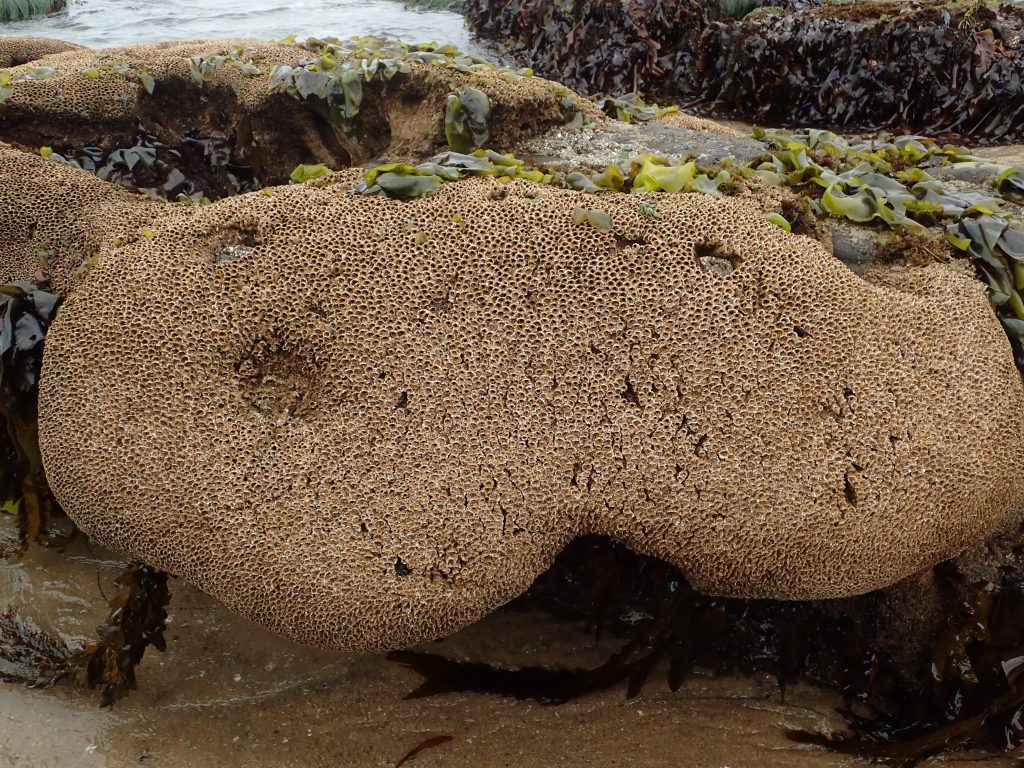
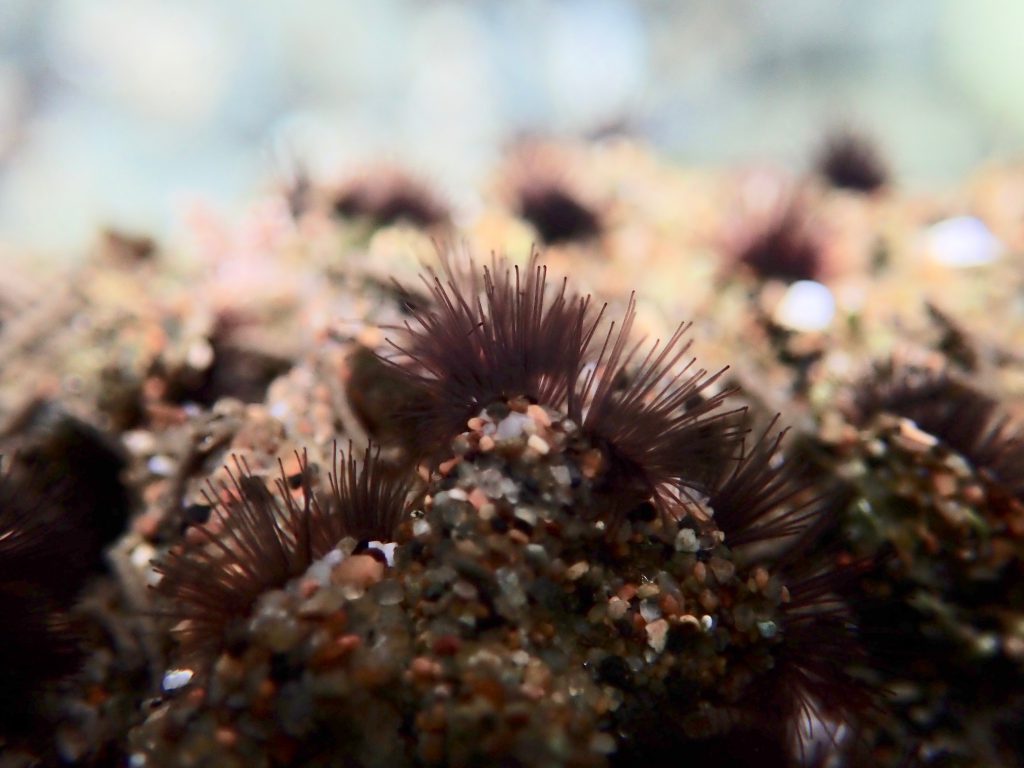
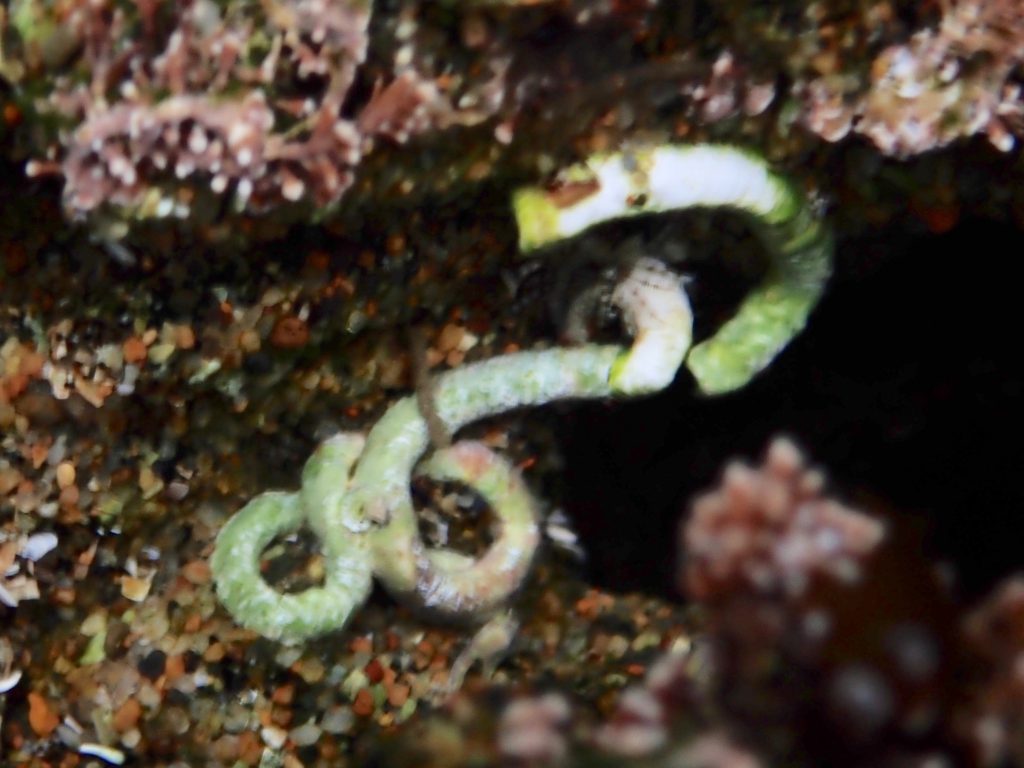

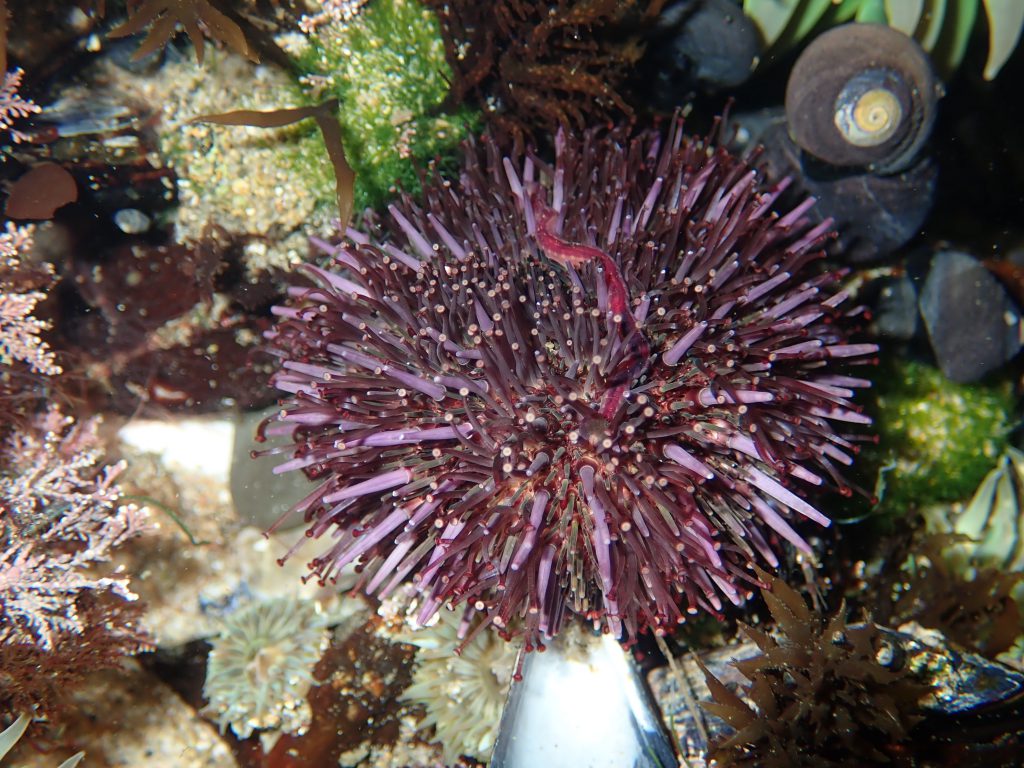
1 thought on “A steady diet of worms”